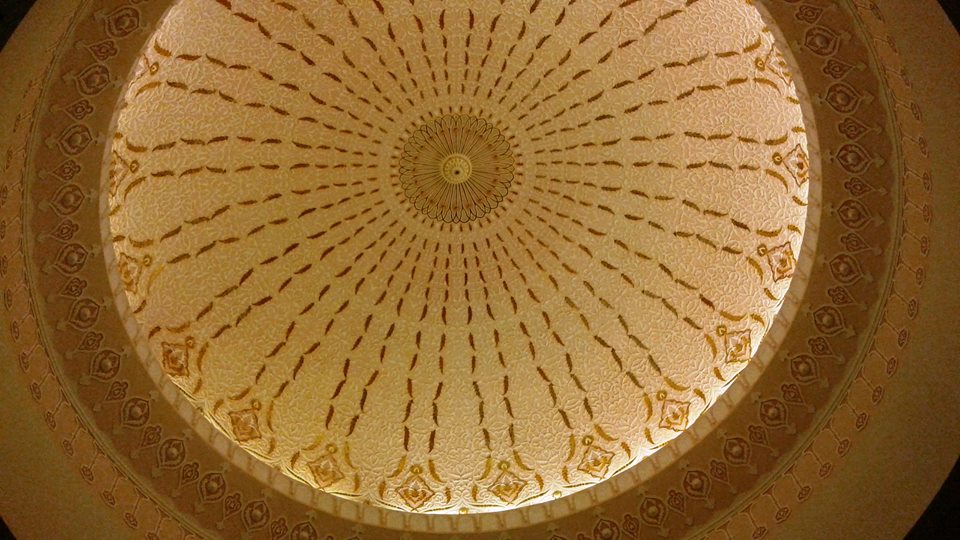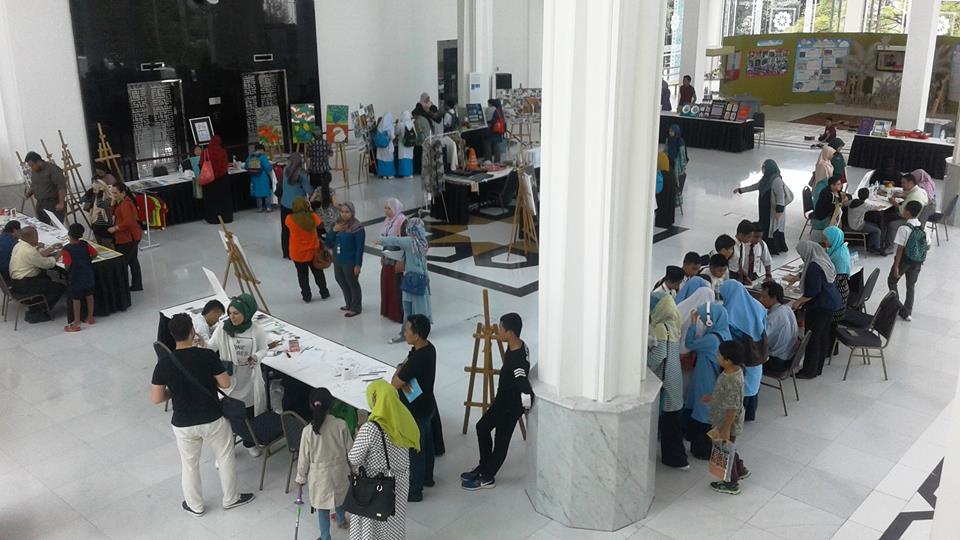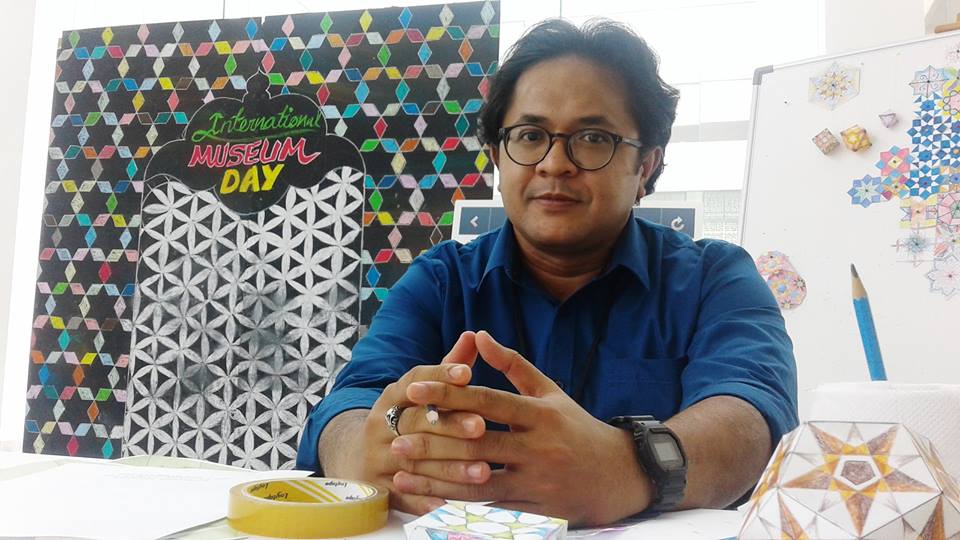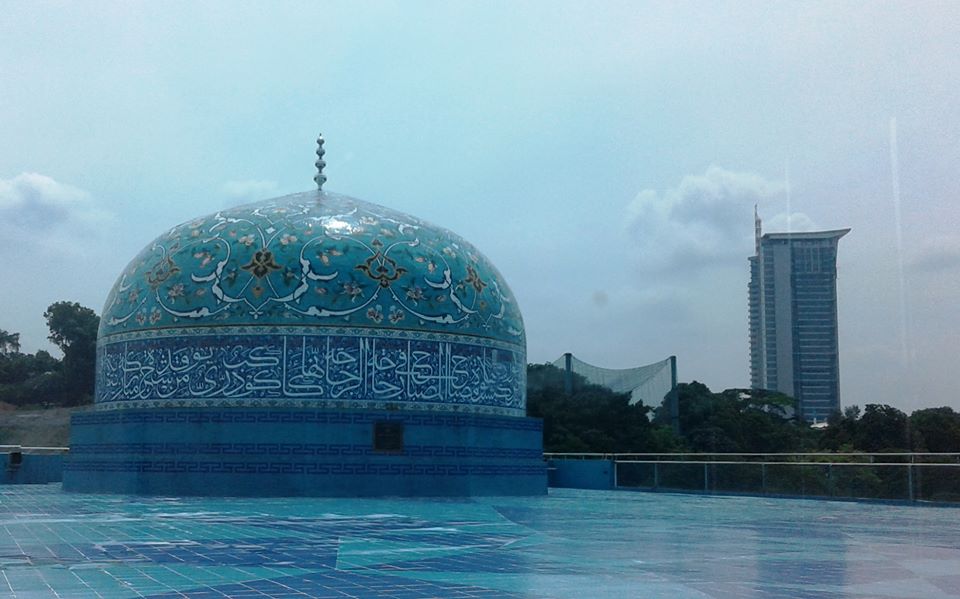IAMM: Showcasing Southeast Asia’s Muslim Heritage

MUHAMMED NOUSHAD visits the Islamic Art Museum Malaysia at Kuala Lumpur on international museum day, walks through the galleries and meets curators. Qatar based The Peninsula newspaper carried this write-up; photographs by MN.
Set in the middle of a lush greenish ambiance, a few hundred meters away from Kuala Lumpur old railway station and very close to the majestic national mosque and the Islamic Center, the Islamic Arts Museum Malaysia (IAMM) is a highly engaging and dynamic place to visit. On May 18th 2016, the International Museum Day, when this writer reached the main lobby of IAMM, it was bustling with scores of school children and youngsters, thanks to the varied educational activities the museum authority had organized for students.
The admission was free for the day and all floors were crowded: mostly Malay school children and Malaysian Chinese youngsters. And a few foreigners, too. Young curators and senior conservationists took visitors for guided tours on different floors. In every gallery and almost all corners you hear curators introducing exhibits to visitors either in Malay or English.
Children, wearing different school uniforms, were finding the joy of creating exquisite and intricate arabesque patterns on ceramics, textiles, glass and their own hands. Special exhibitions and workshops were available. An otherwise calm and quiet Wednesday was fully charged now, as the museum day celebrations kept the entire museum staff of all departments very busy organizing things. In total, a festive mood.
In the special gallery on the ground floor, an ongoing in-house exhibition set a mystical mood for a visitor interested in Islamic mysticism. Named after Dalai’l Al Khayrat, a popular prayer book written by the 15th century Moroccan Sufi master Imam Al Jazuli, the exhibition was full of exotic and antique prayer manuscripts collected from different Muslim lands, across 16th to 19th centuries. All of them, in different calligraphic styles and geographically specific decorative patterns, depicted the meticulous and meditative perfection of Muslim craftsmen who lived across centuries and continents, working on the same text written by a great Sufi. Another example of a text literally transcending through time and space, with a lot of pious veneration and mystical aesthetics attached to it.
Rozela Mohamad Dahlan, manager of the education department of the museum, was leading the educational activities on the workshop hall of the museum; she was being helped by her colleagues, volunteers, school teachers etc. A vibrant Malay lady, Rozela briefed the main attractions of the day: Learn about Geometric Pattern, Hand Painting, Creative Art Corner, Qasidah Performance, Arts and Crafts Corner, Storytelling, Arabic Calligraphy Demonstration, Meet the Little Artist etc.
Rozela also talked about the regular activities of the museum, which included weekend sessions to teach calligraphy, percussion, hand painting and lot more. Many children and youngsters are benefitted and given orientation to their own aesthetical and cultural traditions through these programmes, she believes.
To mark the museum day, IAMM Children’s Library organized programmes with an aim to cultivate creativity through arts and stories. Apart from regular weekend workshops, this day was special and colourful.
A lot of Malay boys and girls were found rejoicing in the halls with their creative potentials being fully explored in different arabesque possibilities on a range of mediums. They made crafts, painted glasses with beautiful patterns on them, and drew calligraphic sketches.
Zulkifli bin Ishak, a young curator educated from International Islamic University of Malaysia, says this privately owned museum is committed to document, preserve and educate about the Islamic art tradition of Southeast Asia and the wider Muslim world. “Our focus is on the artistic traditions of the Islamic world in general and the Malay world in particular. This museum has collected ceramics, textiles, jewellery, architectural models and other artifacts from Spain to Southeast Asia. The curatorial departments are keenly conducting different research projects and the museum publishes journals to reach out to the academic community and general public. We also collaborate with international museums and hold traveling exhibitions. We have hosted exhibitions in association with the British Museum and different universities in the west”, says Zulkifli.
One of the most striking galleries of IAMM is the architecture section – the traditional mosque architecture across the Muslim world is enchantingly recreated here, with particular attention to Malay and Chinese world.
The traditional mosques of the Malay peninsula have miniatures and replicas in the gallery, with decorative elements and functional details given proper attention. Apart from the Malay region, mosques as distant from Cordoba to India are recreated here. Quran manuscripts are another amazing section where the collection of different styles of writing is vivid – from the very tiny gift-type locket Qurans to huge ones.
The IAAM has classified its collection into 12 galleries, some based on the geographical areas the artifacts came from and some based on the material type. It educates and enlightens a viewer with its focused concerns on India, China, Malay world, Textiles, Jewellery, Arms and Armour, Coins, Metalwork, Ceramic and Glass and Living with Wood.
On the ground floor, there is a beautiful fountain garden courtyard and a museum restaurant which specializes in the West Asian cuisine – the ambience is stylish and exotic. The most tempting part would be the museum shop – a colourful, alluring repository of handicrafts from around the world – from small size cards and books to charming ceramic works to elaborate and expensive jewellery.
Arif Rahidy, an official working at the store explains that they import articles mainly from Turkey and Egypt apart from the artifacts they make with the help of the artisans employed at the Musuem workshop. Many travelers visiting Malaysia take their souvenirs from here – very unique and exotic. The shop even facilitates international courier service for those who do not want to carry it home.
It is surprising to know that IAMM, established in 1998, is not an official governmental venture, but a non-profit organization supported by Al Bukhary Foundation.
The museum building itself is a combination of traditional and modern architectural concepts. The museum was designed by Uzbek architects and the decorative works were done by Iranian craftsmen.
[Link to the original publication in The Peninsula: http://thepeninsulaqatar.com/views/opinion/385031/iamm-showcasing-southeast-asia-s-muslim-heritage ]


